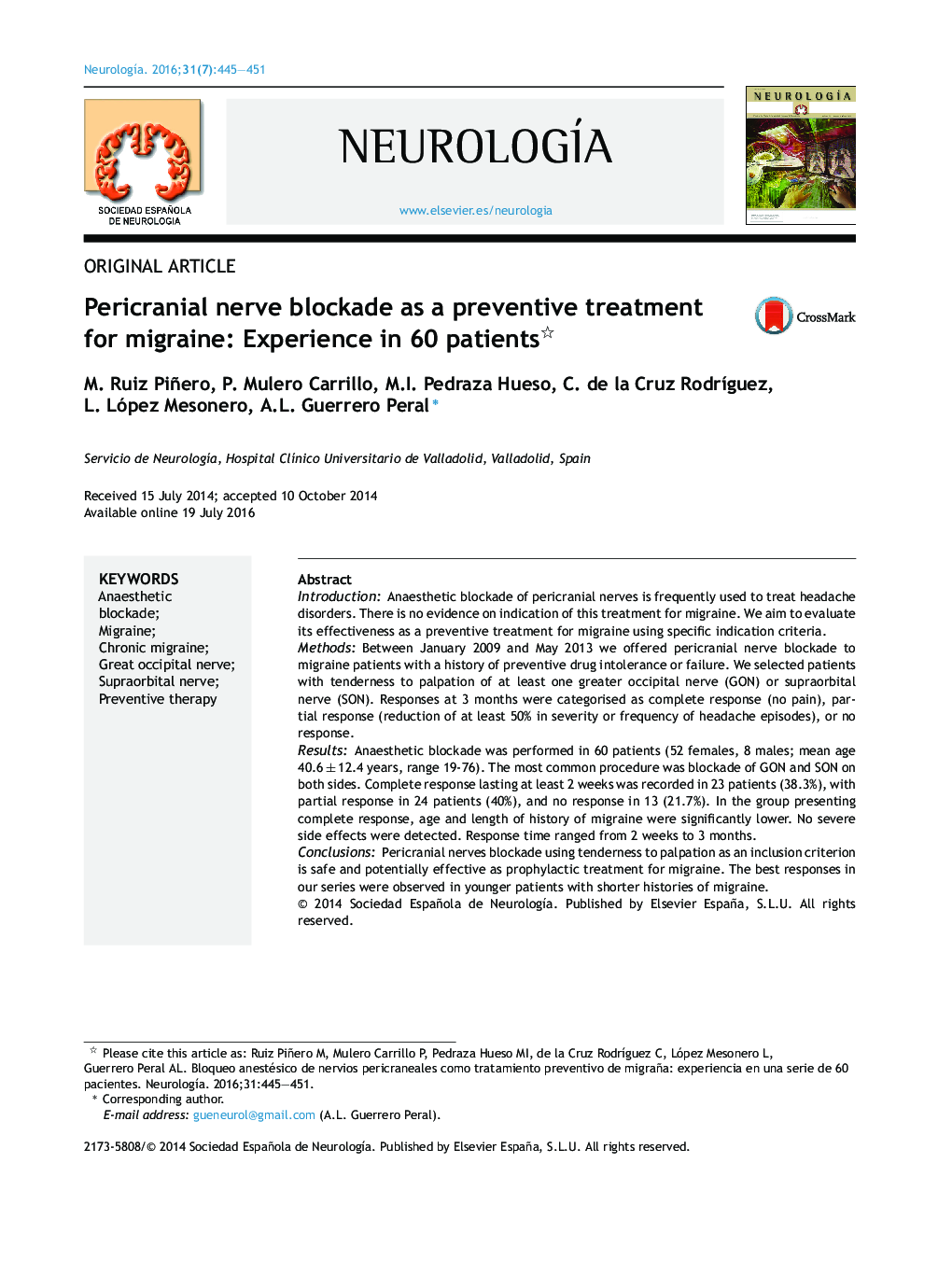| کد مقاله | کد نشریه | سال انتشار | مقاله انگلیسی | نسخه تمام متن |
|---|---|---|---|---|
| 3077003 | 1581001 | 2016 | 7 صفحه PDF | دانلود رایگان |
IntroductionAnaesthetic blockade of pericranial nerves is frequently used to treat headache disorders. There is no evidence on indication of this treatment for migraine. We aim to evaluate its effectiveness as a preventive treatment for migraine using specific indication criteria.MethodsBetween January 2009 and May 2013 we offered pericranial nerve blockade to migraine patients with a history of preventive drug intolerance or failure. We selected patients with tenderness to palpation of at least one greater occipital nerve (GON) or supraorbital nerve (SON). Responses at 3 months were categorised as complete response (no pain), partial response (reduction of at least 50% in severity or frequency of headache episodes), or no response.ResultsAnaesthetic blockade was performed in 60 patients (52 females, 8 males; mean age 40.6 ± 12.4 years, range 19-76). The most common procedure was blockade of GON and SON on both sides. Complete response lasting at least 2 weeks was recorded in 23 patients (38.3%), with partial response in 24 patients (40%), and no response in 13 (21.7%). In the group presenting complete response, age and length of history of migraine were significantly lower. No severe side effects were detected. Response time ranged from 2 weeks to 3 months.ConclusionsPericranial nerves blockade using tenderness to palpation as an inclusion criterion is safe and potentially effective as prophylactic treatment for migraine. The best responses in our series were observed in younger patients with shorter histories of migraine.
ResumenIntroducciónEl bloqueo anestésico de nervios pericraneales es utilizado con frecuencia en el tratamiento de diferentes cefaleas. No hay evidencia acerca de su indicación en pacientes migrañosos. Pretendemos evaluar su eficacia como tratamiento preventivo de migraña con criterios determinados.MétodosEntre enero del 2009 y mayo del 2013 se ofreció este tratamiento a migrañosos con fracaso o intolerancia de fármacos preventivos. Seleccionamos a aquellos con sensibilidad a la palpación en al menos un nervio supraorbitario u occipital mayor. A los 3 meses, consideramos la respuesta completa (sin dolor), parcial (reducción al menos de un 50% en severidad y/o frecuencia de episodios) o ausente.ResultadosSe practicó un bloqueo anestésico en 60 pacientes (52 mujeres, 8 varones, edad media ± desviación estándar: 40,6 ± 12,4 años, rango 19-76). El procedimiento más habitual fue el bloqueo de ambos nervios occipitales y supraorbitarios. Hubo respuesta completa de al menos 2 semanas en 23 (38,3%), parcial en 24 (40%) y ausente en 13 (21,7%). En el grupo con respuesta completa, la edad y el tiempo de evolución de la migraña eran significativamente inferiores. Sin efectos adversos significativos. Tiempo de respuesta entre 2 semanas y 3 meses.ConclusionesEl bloqueo anestésico de nervios pericraneales utilizando la sensibilidad a la palpación como criterio de selección es un procedimiento seguro y potencialmente eficaz como tratamiento preventivo de migraña. Las mayores respuestas en nuestra serie se observan en pacientes jóvenes con menos tiempo de evolución de la migraña.
Journal: Neurología (English Edition) - Volume 31, Issue 7, September 2016, Pages 445–451
